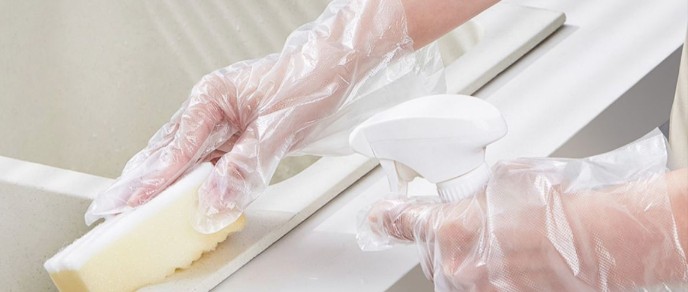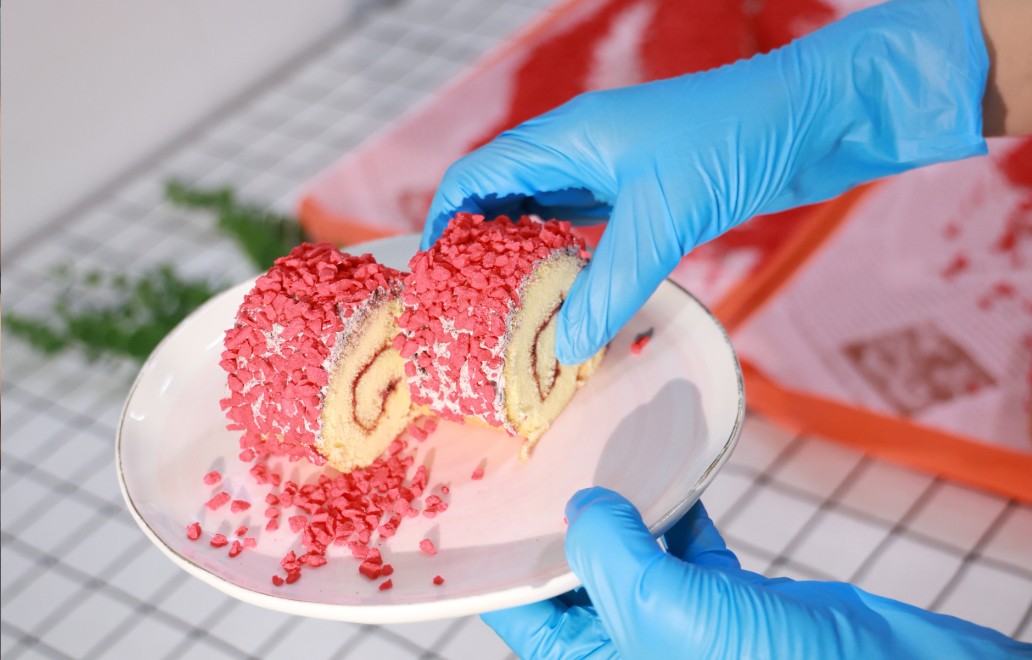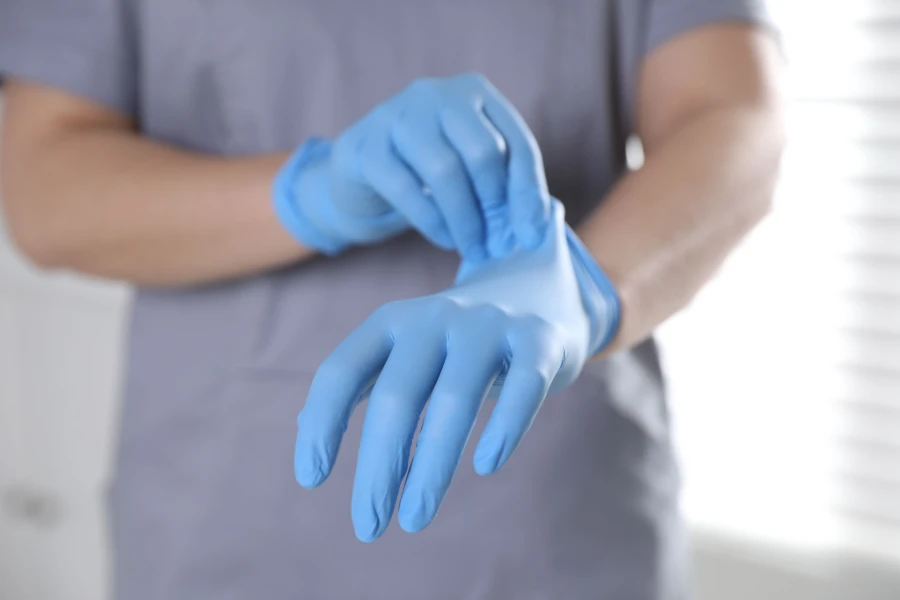What Are Nitrile Disposable Gloves Made Of and Do They Contain Latex
Do nitrile disposable gloves contain latex? No, nitrile disposable gloves do not contain latex. Nitrile is a synthetic rubber that provides strong and flexible protection for your hands without any natural latex proteins. This makes nitrile gloves a safe choice for people with latex allergies. Approximately 4.3% of the global population has latex allergies, and nearly 17% of healthcare and food industry workers require latex-free gloves to prevent allergic reactions.

Do Nitrile Disposable Gloves Contain Latex
Nitrile Composition
Have you ever wondered what nitrile disposable gloves are made of? Companies make these gloves from nitrile butadiene rubber, also called NBR. NBR is a type of synthetic rubber copolymer. It is made when acrylonitrile and butadiene mix. This happens during a process called polymerisation. This process helps the gloves become strong and bendy. Other chemicals are added to make the gloves last longer and stretch better.
Nitrile gloves do not have any natural latex proteins. This makes them different from latex gloves. To make the gloves, workers mix the main materials. Then, they dip hand-shaped moulds into the nitrile mixture. After that, the gloves are heated to make them tough and steady. The finished gloves are strong, flexible, and safe for many jobs.
Note: Nitrile gloves are checked carefully for quality. These checks make sure the gloves are safe and do not have unwanted things in them.
Latex-Free Properties
Do nitrile disposable gloves have latex? The answer is no. Nitrile gloves are latex-free. Tests in labs show these gloves do not have any latex or latex proteins. This makes them safe for people who are allergic to latex. You can wear nitrile gloves without worrying about a latex allergy.
Companies work hard to keep nitrile gloves free from latex. They use only man-made materials and check for latex proteins during production. Quality teams look for any signs of latex in the gloves. These steps help keep the gloves latex-free from start to finish.
Here are some myths and facts:
• Some people think nitrile gloves have natural latex, but they do not.
• Allergies to nitrile gloves can happen because of other chemicals, not latex.
• People sometimes mix up allergies to nitrile gloves with latex allergies.
• Not just latex gloves can cause allergies; nitrile gloves can too, but for other reasons.
You can trust that regular nitrile disposable gloves do not have latex. If you ask, do nitrile disposable gloves contain latex? Now you know the answer. Nitrile gloves are a safe choice for people who need protection without latex.
Materials and Manufacturing
Production Process
You may wonder how nitrile gloves are made. The process uses new technology to make strong, bendy gloves. Here is what happens:
-
Factories mix butadiene and acrylonitrile to make liquid nitrile rubber.
-
They add antioxidants and stabilisers to keep the rubber strong.
-
Workers clean hand-shaped moulds and coat them so gloves do not stick.
-
The moulds dip into the liquid nitrile to form a thin glove layer.
-
The gloves bake at high heat to cure and harden.
-
Factories treat gloves with special coatings for easy wearing.
-
Workers take the gloves off the moulds and check them for quality.
Modern gloves, like INTCO Syntex™, use new formulas for extra softness and stretch. These gloves are better for the environment. They use less sulphur and energy, so there are fewer emissions. Syntex™ gloves do not use natural rubber, so they do not hurt forests or soil.
🌱 Note: Picking synthetic, latex-free gloves helps keep you and the planet safe.
Allergy Safety
Latex Allergy Suitability
You might ask if nitrile gloves are safe for people with latex allergies. The answer is yes. Nitrile gloves do not have natural latex proteins. This means they will not cause latex-type allergic reactions. If you wonder, do nitrile disposable gloves contain latex? You can be sure the answer is no. That is why many people who need to avoid latex pick these gloves.
Manufacturers use strict tests to make sure nitrile gloves are safe. Here is how they check the gloves:
-
Look for tears, holes, or colour changes before using.
-
Fill gloves with water to see if there are leaks.
-
Make sure gloves fit well to protect your hands.
-
Follow FDA rules for safety and skin protection.
-
Change gloves right away if you see any damage.
-
Pick powder-free gloves to lower allergy risks.
🩺 Tip: If you have a latex allergy, always use powder-free nitrile gloves. This helps lower your chance of skin problems.
You can also check the table below to see how tests keep you safe:
|
Testing Protocol |
Why It Matters for You |
|---|---|
|
Tensile Strength Test |
Checks if gloves stretch and stay strong. |
|
Pinhole Leak Test |
Finds tiny holes that could let in germs or allergens. |
|
Puncture Resistance Test |
Make sure gloves protect against sharp objects. |
|
Biocompatibility Testing |
Confirms gloves are safe for your skin and do not cause latex allergies. |
|
Powder Residue Testing |
Ensures gloves are powder-free to avoid extra allergy risks. |
|
Accelerated Aging Test |
Checks if gloves stay safe after storage. |
|
Regulatory Certifications |
Shows gloves meet strict safety rules for allergy prevention. |
Other Sensitivities
Nitrile gloves do not have latex, but some people can still react. These reactions are not from latex. They come from chemicals used to make the gloves. Chemicals like thiurams, carbamates, and thiazoles can cause skin redness, itching, or mild burns. This is called allergic contact dermatitis.
You might notice these signs if you are sensitive:
• Itching or redness on your hands
• Mild burning feeling
• No swelling or trouble breathing
A study with dental workers found about 15% of people using nitrile gloves had mild symptoms like itching. More than 85% of latex glove users had worse reactions, like swelling and trouble breathing. This means sensitivities to nitrile gloves are less common and not as serious as latex allergies.
⚠️ Note: If your skin is sensitive, you can use accelerator-free nitrile gloves. These gloves do not have the chemicals that cause most reactions.
Doctors suggest patch testing if you think you have a glove allergy. You can also wear a thin cotton or polyethylene liner under your gloves to protect your skin. Always choose gloves that fit well and check for any signs of irritation.
Glove Comparison
Nitrile vs. Latex
When you look at nitrile and latex gloves, you see big differences. Nitrile gloves do not have natural rubber proteins. This means people with latex allergies can use them safely. Latex gloves can cause allergies for some people. In hospitals, most allergies come from latex gloves. Only a few allergies come from nitrile gloves.
Nitrile gloves protect better from sharp things and chemicals. They make a stronger barrier for your hands. This is good if you use sharp tools or work with chemicals. Latex gloves feel softer and let you move your hands more. But they do not last as long as nitrile gloves.
Here is a table about allergy rates:
|
Glove Type |
Percentage of Allergic Reactions (%) |
|---|---|
|
Latex |
85.14 |
|
Nitrile |
14.85 |
🩺 Tip: If you wonder, does nitrile disposable gloves contain latex, the answer is no. Nitrile gloves are safer for people who have latex allergies.
Nitrile vs. Vinyl
Nitrile gloves and vinyl gloves are both made from synthetic materials. But they are not the same. Nitrile gloves are stronger and protect better from holes and chemicals. Vinyl gloves can tear or break more easily, especially if you move your hands a lot.
Nitrile gloves fit your hands better and feel more comfortable. They stretch and move with you, so you can work safely. Vinyl gloves cost less money. But they are best for quick jobs that are not risky.
Use Cases
Nitrile gloves are used in many jobs because they are strong and safe. Here are some ways people use them:
• Hospitals and clinics use nitrile gloves for patient care and surgery.
• Dentists pick nitrile gloves to avoid latex allergies and for a better grip.
• Labs and chemical plants use nitrile gloves for chemical safety.
• Beauty salons and tattoo shops use nitrile gloves for comfort and safety.
• Food factories use nitrile gloves to keep food clean.
• Factories use nitrile gloves to protect workers’ hands.
Vinyl gloves are good for food service and other easy jobs. Latex gloves are still used in some medical and cleaning jobs. But many people now like nitrile gloves best because they are safe and strong.
Now you know if nitrile disposable gloves have latex. Nitrile gloves do not have latex. You can use them if you are allergic to latex. They protect your hands well and keep out chemicals. Nitrile gloves fit your hands and feel comfortable. Many workers pick nitrile gloves because they last a long time. They are also easy to recycle. If you want more comfort and safety, try advanced synthetic gloves like INTCO Syntex™.


























